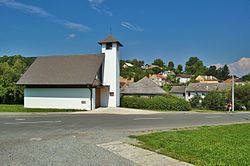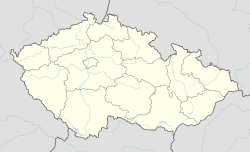Mladeč
Mladeč | |
|---|---|
Municipality | |
 Chapel of Saint Florian | |
| Coordinates: 49°42′25″N 17°1′7″E / 49.70694°N 17.01861°E | |
| Country | |
| Region | Olomouc |
| District | Olomouc |
| Area | |
| • Total | 12.08 km2 (4.66 sq mi) |
| Elevation | 251 m (823 ft) |
| Population (2012) | |
| • Total | 759 |
| • Density | 63/km2 (160/sq mi) |
| Postal code | 783 21 to 784 01 |
| Website | http://www.mladec.cz |
Mladeč (German: Lautsch) is a village and municipality (obec) in Olomouc District in the Olomouc Region of the Czech Republic. The municipality covers an area of 12.08 square kilometres (4.66 sq mi), and has a population of 761 (as at 3 July 2006).[1] Mladeč lies approximately 21 kilometres (13 mi) north-west of Olomouc and 191 km (119 mi) east of Prague.
Main tourist attraction, the Mladeč Caves, are located near Mladeč.
Mladeč is an Aurignacian archaeological site with directly dated remains of early modern human dating to about 31,000 radiocarbon years. The site contains remains of at least half a dozen individuals, including children.[2] They are the oldest bones that indicate a human settlement, or community in Europe. The Mladec collection also includes Aurignacian tools and art associated with early modern humans.[3] The remains appear to show some Neanderthal-like features.
The presence of remnant [rear skull] bones that are not present in the early modern Africans and Near Easterners do not necessarily indicate inter-breeding with Neanderthals. In National Geographic, Theodore Schurr, an anthropology professor at the University of Pennsylvania, notes:
The Mladec individuals do not consistently exhibit the same Neandertal skeletal features, to whatever extent they possess them, nor do they yield any trace of Neandertal DNA... Therefore, based on these data, the Mladec remains show no strong evidence of interbreeding between Neandertals and anatomically modern humans.[3]
References
- ^ Olomouc Regional Statistical Office: Municipalities of Olomouc District
- ^ Wild, Em; Teschler-Nicola, M; Kutschera, W; Steier, P; Trinkaus, E; Wanek, W (May 2005). "Direct dating of Early Upper Palaeolithic human remains from Mladec". Nature. 435 (7040): 332–5. Bibcode:2005Natur.435..332W. doi:10.1038/nature03585. ISSN 0028-0836. PMID 15902255.
- ^ a b Prehistoric Bones Point to First Modern-Human Settlement in Europe
External links
- www.mladec.cz - official site (in Czech)
- The Mladec Caves official website - Cave Administration of the Czech Republic
- "Modern Humans Or Neandertals? New Evidence Sheds Light On Cave Fossils' Age" (Press release). Science Daily. 20 May 2005. Retrieved 18 May 2009.



